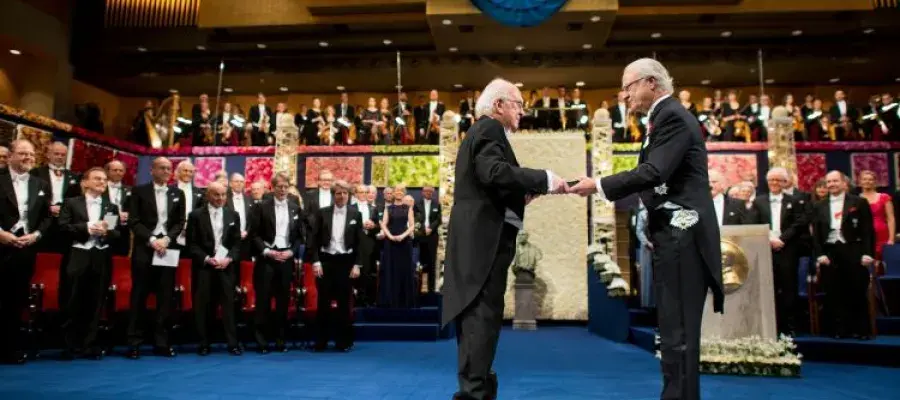
The University of Edinburgh has become the steward of one of the most iconic symbols in modern physics – the Nobel Prize medal awarded to Professor Sir Peter Higgs. The late physicist chose the university, where he first introduced his groundbreaking theory, to house this precious artifact and to ensure that his discovery continues to inspire future generations.
Peter Higgs: From Newcastle to the Cosmos
Born in 1929 in Newcastle upon Tyne, Peter Higgs pursued physics with a passion that would eventually reshape the field. In 1960 he joined the University of Edinburgh’s Tait Institute of Mathematical Physics as a lecturer, later becoming the Personal Chair of Theoretical Physics in 1980. While still on the faculty, Higgs proposed the mechanism that would later give particles mass – the Higgs boson – a concept that went on to be validated at CERN in 2012.
The Nobel Prize and Its Significance
In 2013, the Nobel Prize in Physics was awarded jointly to Professor Higgs and Professor François Englert for their independent theoretical insights that explained why particles have mass. The medal, a symbol of global scientific excellence, is now preserved by the university’s Centre for Research Collections and will be displayed at special events, including the 2026 Higgs Lecture.
Did you know? The Higgs boson is often called the “God particle” in popular media, though the more scientific community discourages that nickname.
The Higgs Centre for Theoretical Physics: Continuing the Journey
Established in 2012, the Higgs Centre grew out of Professor Higgs’s legacy and the university’s commitment to cutting‑edge research. It serves as a hub for scholars worldwide, offering collaborative spaces, funding opportunities, and a curriculum that challenges students to ask the very questions that Higgs did.
Research Opportunities for Students
Undergraduate and postgraduate students can engage with the centre through:
- Postgraduate scholarships that focus on particle physics and quantum field theory.
- Internship programs with CERN and other leading research labs.
- Annual seminars led by visiting professors and alumni.
Academic Pathways Aligned With Higgs’s Work
The university offers a range of courses that reflect the foundation laid by Higgs, including:
- PhD in Theoretical Physics – tailored to explore spontaneous symmetry breaking and gauge theories.
- BSc (Hons) in Physics – with optional modules on collider physics and data analysis.
- Cross‑disciplinary electives combining physics with computing and mathematical modelling.
Future Events: The 2026 Higgs Lecture
Mark your calendar for the upcoming Higgs Lecture scheduled for 2026. The event will feature leading physicists, young researchers, and former students who have been influenced by Professor Higgs’s theory. As an institution, the university will display the Nobel medal, bridging history with contemporary scientific discourse.
Upcoming Events Calendar
- October 2025 – Symposium on Spontaneous Symmetry Breaking.
- December 2025 – Alumni Networking Night.
- March 2026 – Higgs Lecture (venue details to be announced).
Why This Matters for Aspiring Scientists
For students considering a career in physics, the donation of the Nobel medal is more than a symbolic gesture; it represents a tangible link to a foundational moment in science. The university can offer:
• A nurturing environment with world‑class faculty.
• Access to facilities like the high‑performance computing centre.
• A vibrant community of peers and mentors who share a passion for uncovering the universe’s secrets.
Engage With the Legacy: How to Join the Community
Studying at the University of Edinburgh gives you the chance to stand on the shoulders of giants. Here’s how you can get involved:
- Explore the physics department’s programmes on the official website.
- Apply for the Bachelor’s or Master’s programmes during the designated admission cycle.
- Reach out to faculty members whose research aligns with your interests.
- Attend public lectures and seminars to gain exposure to cutting‑edge research.
By pursuing your studies at the university, you will inherit a tradition of excellence and contribute to the next wave of discovery.
Conclusion: A Testament to Enduring Science
The donation of Sir Peter Higgs’s Nobel Prize medal reaffirms the University of Edinburgh’s role as a steward of scientific heritage and a launchpad for future breakthroughs. The centre, the lecture series, and the ongoing research programmes ensure that the university remains at the forefront of theoretical physics, offering students and scholars a unique platform to advance the field.
To learn how you might become part of this legacy, consider taking the next steps below.
Next Steps
- Schedule a campus tour to see the Higgs Centre and the Nobel medal display.
- Apply for the undergraduate physics programmes to begin your journey.
- Contact the admissions office for tailored guidance on your application.
- Follow the university’s social media channels for updates on the Higgs Lecture and related events.

